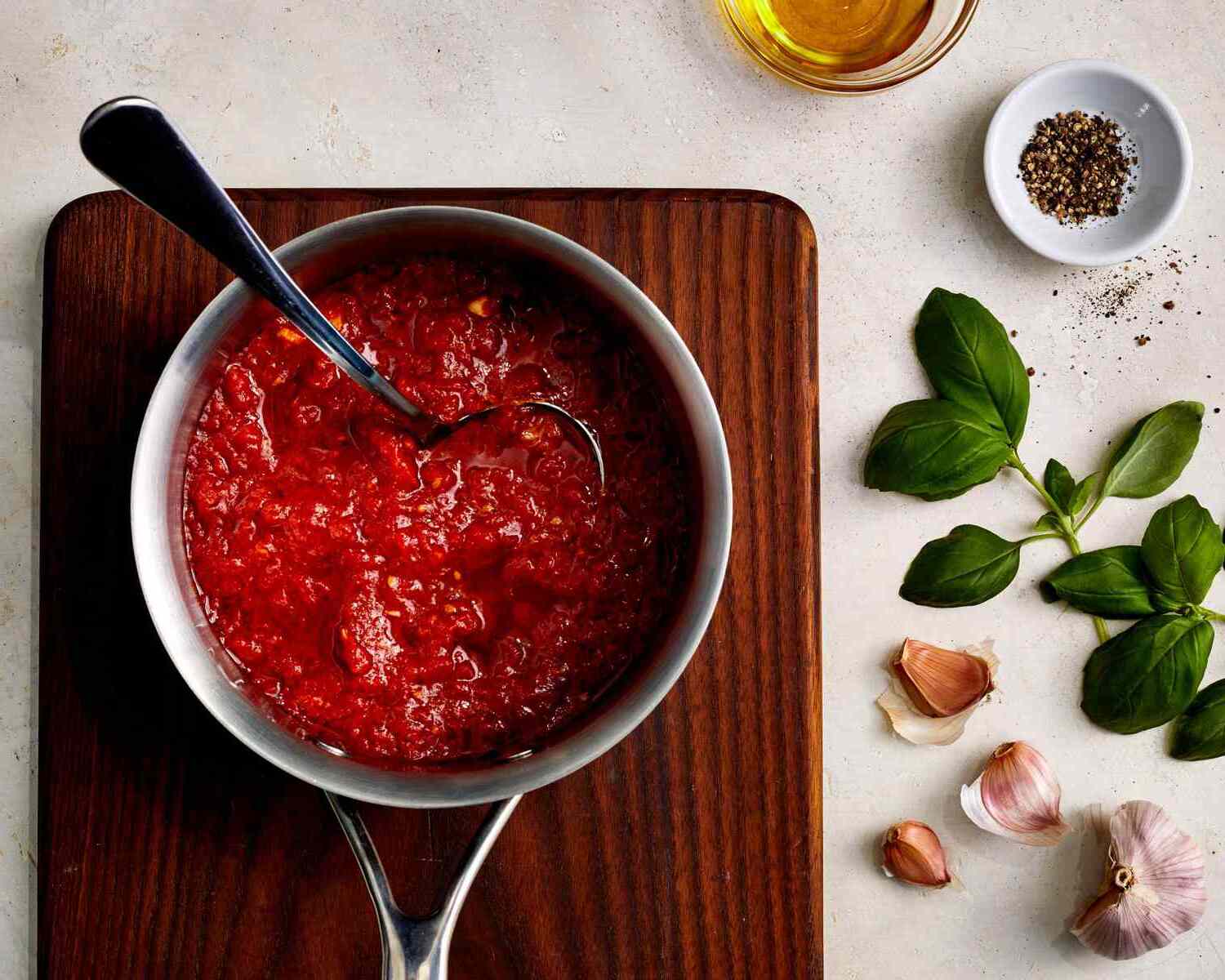Dive into the heart of Italian cuisine with this classic marinara sauce recipe. Perfect for pasta, pizza, or as a dipping sauce, this recipe brings together simple ingredients to create a rich and flavorful sauce. The combination of aromatic olive oil, sweet onions, and fresh basil creates a symphony of flavors that will transport your taste buds straight to Italy. Whether you're a seasoned chef or a kitchen novice, this marinara sauce is easy to make and sure to impress.
While most of the ingredients for this marinara sauce are pantry staples, fresh basil might not be something you have on hand. It's worth the trip to the supermarket for its vibrant flavor that elevates the sauce. Additionally, ensure you have crushed canned tomatoes, as they form the base of the sauce and provide the rich tomato flavor essential to a good marinara.

Ingredients For Marinara Sauce Recipe
Olive oil: This is used as the base for sautéing the onions and garlic, adding a rich, fruity flavor to the sauce.
Onion: Finely chopped, it adds sweetness and depth to the sauce as it cooks down.
Garlic: Minced garlic infuses the sauce with a pungent, aromatic flavor that is quintessential to Italian cooking.
Crushed canned tomatoes: These provide the rich, tomatoey base of the sauce, offering both texture and flavor.
Salt: Enhances the flavors of the other ingredients, bringing balance to the sauce.
Sugar: A small amount of sugar helps to balance the acidity of the tomatoes, creating a smoother taste.
Dried oregano: Adds a hint of earthy, herbal flavor that complements the tomatoes and garlic.
Black pepper: Provides a subtle heat and depth to the sauce.
Fresh basil: Chopped and added at the end, it brings a fresh, aromatic finish to the sauce.
Technique Tip for Perfecting This Sauce
To enhance the flavor of your marinara sauce, consider using high-quality olive oil as the base. When cooking the onion, ensure it becomes translucent but not browned, as this will provide a sweeter, more subtle flavor. When adding the garlic, be cautious not to burn it, as burnt garlic can impart a bitter taste. Opt for crushed canned tomatoes that are known for their rich flavor and low acidity. Adjust the salt and sugar to balance the acidity of the tomatoes to your taste. Fresh basil should be added towards the end of the cooking process to preserve its vibrant flavor and aroma.
Suggested Side Dishes
Alternative Ingredients
olive oil - Substitute with canola oil: Canola oil has a neutral flavor and similar cooking properties, making it a good alternative for sautéing.
olive oil - Substitute with butter: Butter adds a rich flavor and can be used for sautéing onions and garlic, though it will change the flavor profile slightly.
onion - Substitute with shallots: Shallots have a milder taste and can add a subtle sweetness to the sauce.
onion - Substitute with leeks: Leeks offer a gentle onion flavor and can be used in equal amounts for a slightly different taste.
garlic - Substitute with garlic powder: Use ¼ teaspoon of garlic powder for each clove of garlic to maintain the garlic flavor.
garlic - Substitute with shallots: Shallots can provide a mild garlic-like flavor when minced finely.
crushed canned tomatoes - Substitute with fresh tomatoes: Blanch, peel, and crush fresh tomatoes to use in place of canned ones for a fresher taste.
crushed canned tomatoes - Substitute with tomato puree: Tomato puree can be used for a smoother texture, though it may be slightly thicker.
salt - Substitute with soy sauce: Soy sauce can add a salty and umami flavor, but use sparingly to avoid overpowering the dish.
salt - Substitute with sea salt: Sea salt can be used in the same amount for a slightly different mineral taste.
sugar - Substitute with honey: Honey can add sweetness with a hint of floral notes, but use slightly less as it is sweeter than sugar.
sugar - Substitute with maple syrup: Maple syrup provides sweetness with a unique flavor, but use in moderation to avoid altering the sauce too much.
dried oregano - Substitute with dried basil: Dried basil can offer a different herbal note while maintaining the Italian flavor profile.
dried oregano - Substitute with Italian seasoning: Italian seasoning includes oregano and other herbs, providing a similar flavor.
black pepper - Substitute with white pepper: White pepper can be used for a milder peppery taste without altering the color of the sauce.
black pepper - Substitute with cayenne pepper: Cayenne pepper adds heat and spice, so use sparingly to avoid making the sauce too spicy.
fresh basil - Substitute with dried basil: Use 1 tablespoon of dried basil for every ¼ cup of fresh basil, though it will have a less vibrant flavor.
fresh basil - Substitute with parsley: Fresh parsley can add a fresh, slightly peppery flavor, though it will change the taste of the sauce.
Alternative Recipes Similar to This Sauce
How to Store or Freeze This Sauce
Allow the marinara sauce to cool completely at room temperature before storing. This prevents condensation, which can lead to a watery sauce.
Transfer the marinara sauce into airtight containers or heavy-duty freezer bags. For easy portioning, consider using smaller containers or dividing the sauce into individual servings.
If using freezer bags, lay them flat in the freezer to save space and ensure even freezing. Once frozen, you can stack them upright like books for efficient storage.
Label each container or bag with the date and contents. This helps you keep track of freshness and ensures you use the oldest sauce first.
Store the marinara sauce in the refrigerator for up to 5 days. For longer storage, place it in the freezer, where it can last for up to 3 months without losing its vibrant flavor.
To thaw frozen marinara sauce, transfer it to the refrigerator and let it defrost overnight. If you're in a hurry, you can also submerge the sealed bag in cold water or use the defrost setting on your microwave.
Reheat the sauce gently on the stovetop over low heat, stirring occasionally. This helps maintain the sauce's rich texture and prevents scorching.
If the sauce appears too thick after reheating, add a splash of water or olive oil to reach your desired consistency. Adjust the seasoning if necessary, as freezing can sometimes dull the flavors.
For a fresh twist, consider adding a handful of chopped fresh basil or a sprinkle of grated Parmesan cheese just before serving. This will enhance the sauce's aroma and taste, making it feel freshly made.
How to Reheat Leftovers
Gently warm the marinara sauce on the stovetop over low heat. Stir occasionally to ensure even heating and prevent sticking. This method preserves the sauce's rich flavors and texture.
Use a microwave-safe bowl to reheat the marinara sauce in the microwave. Cover the bowl with a microwave-safe lid or wrap to avoid splatters. Heat in 30-second intervals, stirring in between, until the sauce is heated through.
For a quick and even reheating, place the marinara sauce in a small saucepan and add a splash of water or olive oil to loosen it up. Heat over medium-low, stirring frequently, until warmed to your liking.
If you're planning to use the marinara sauce as a topping for pasta, consider reheating it in a skillet. Add the sauce to the skillet and toss in the cooked pasta, allowing the sauce to coat the pasta evenly as it heats.
For a slow and gentle reheating, use a double boiler. Place the marinara sauce in the top part of the double boiler and allow the steam from the simmering water below to warm the sauce gradually, preserving its delicate flavors.
Essential Tools for Making This Sauce
Saucepan: A medium-sized saucepan is essential for cooking the marinara sauce, allowing for even heat distribution and easy stirring.
Wooden spoon: A wooden spoon is ideal for stirring the sauce as it won't scratch the surface of your saucepan and provides good control.
Chef's knife: A sharp chef's knife is necessary for finely chopping the onion and mincing the garlic efficiently.
Cutting board: A sturdy cutting board provides a safe and stable surface for chopping the onion and mincing the garlic.
Measuring spoons: Measuring spoons are used to accurately measure the olive oil, salt, sugar, oregano, and black pepper.
Can opener: A can opener is needed to open the can of crushed tomatoes.
Mixing bowl: A small mixing bowl can be used to hold the chopped basil until it's ready to be added to the sauce.
Time-Saving Tips for Making This Sauce
Prepare ingredients in advance: Chop the onion and mince the garlic ahead of time to streamline the cooking process.
Use a food processor: Quickly chop the onion and basil using a food processor to save time.
Opt for pre-crushed tomatoes: Purchase crushed canned tomatoes to skip the step of breaking down whole tomatoes.
Simmer while multitasking: Let the sauce simmer while you prepare other parts of your meal.
Batch cooking: Double the recipe and freeze extra sauce for future meals, saving time on busy days.

Marinara Sauce Recipe
Ingredients
Main Ingredients
- 2 tablespoon Olive Oil
- 1 medium Onion, finely chopped
- 3 cloves Garlic, minced
- 800 g Canned Tomatoes crushed
- 1 teaspoon Salt
- 1 teaspoon Sugar
- 1 teaspoon Dried Oregano
- ¼ teaspoon Black Pepper
- ¼ cup Fresh Basil chopped
Instructions
- Heat the olive oil in a saucepan over medium heat.
- Add the chopped onion and cook until translucent, about 5 minutes.
- Add the minced garlic and cook for another minute.
- Stir in the crushed tomatoes, salt, sugar, oregano, and black pepper.
- Bring to a simmer and cook for 20-30 minutes, stirring occasionally.
- Stir in the fresh basil and cook for another 5 minutes.
- Remove from heat and let cool slightly before serving.
Nutritional Value
Keywords
Suggested Appetizers and Desserts
More Amazing Recipes to Try 🙂
- Garlic Shrimp Pasta30 Minutes
- Quinoa Stuffed Bell Peppers45 Minutes
- Watermelon Feta Salad15 Minutes
- Ricotta Cheese Recipe40 Minutes
- Pizza Sauce Recipe30 Minutes
- Southern Coleslaw Recipe15 Minutes
- Garlic Sauce Recipe15 Minutes
- Swedish Meatball Sauce Recipe25 Minutes


Leave a Reply